| Followers | 679 |
| Posts | 140822 |
| Boards Moderated | 36 |
| Alias Born | 03/10/2004 |
Sunday, June 06, 2021 5:51:12 PM
By: Mark J Lundeen | June 6, 2021
This week closed with the Dow Jones’ BEV at -0.06%. In dollar terms the Dow Jones has to advance only twenty-two dollars to once again make market history with a new all-time high. That will be BEV Zero (0.00%) #30 seen below since its March 2020 BEV -37% flash-crash low.
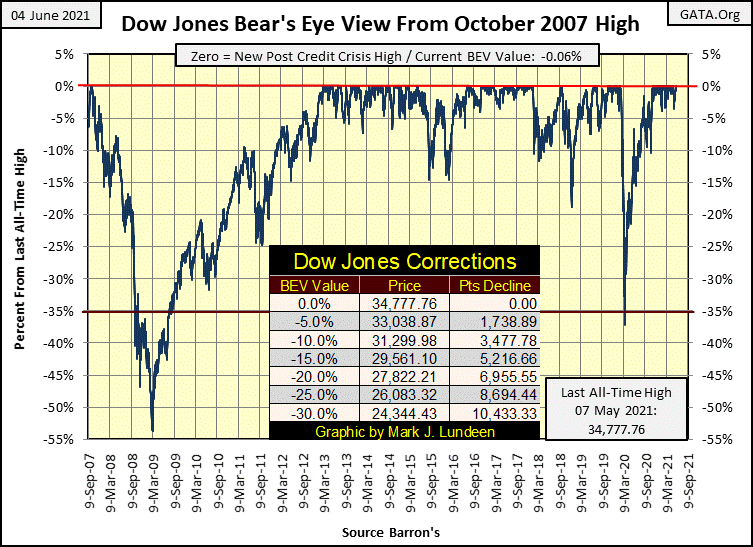
This is damn bullish. It’s also a damn inflationary farce foisted upon a trusting world by the Federal Reserve’s FOMC.
Look at the two big market declines in this BEV chart. The Sub-Prime Mortgage bear market (October 2007 to March 2009), from its last BEV Zero in October 2007 to when it first broke below 37%, took 253 NYSE trading sessions. Last years’ 37% (out from nowhere) decline took only 27 NYSE trading sessions to accomplish the same, and that is a big problem to my way of thinking.
Apparently, others were thinking along these same lines. Immediately following this 27-day burst of deflation from Mr Bear, the idiot savants at the FOMC instituted their Not QE#4, and “injected” $1.3 trillion dollars of “liquidity” into the financial system in the following month; April 2020.
The idiots made their point. Much like Comrade Stalin’s command to the Red Army at the Battle of Stalingrad: “Not one Step Backward.” The Dow Jones would not be allowed to deflate below its BEV -40% line in the following days. Only God knows how much further the Dow Jones would have declined had natural market forces be allowed to discover the stock market’s fair market value. I have to believe it would have deflated far below the Sub-Prime Mortgage’s bear market low of a BEV -53%.
Now in June 2021, we’re looking at the Dow Jones make its thirtieth BEV Zero in the post March 2020 bottom’s advance above. Go bulls go! As seen below in my table of Major Market Indexes BEV Valuations below; they are.
The past month has seen a dearth of BEV Zeros in the table below. But these indexes remained in scoring position, or less than 5% from their last BEV Zeros. Then at this week’s close, seven of these major indexes closed at new all-time highs. I expect more of the same at the end of next week.
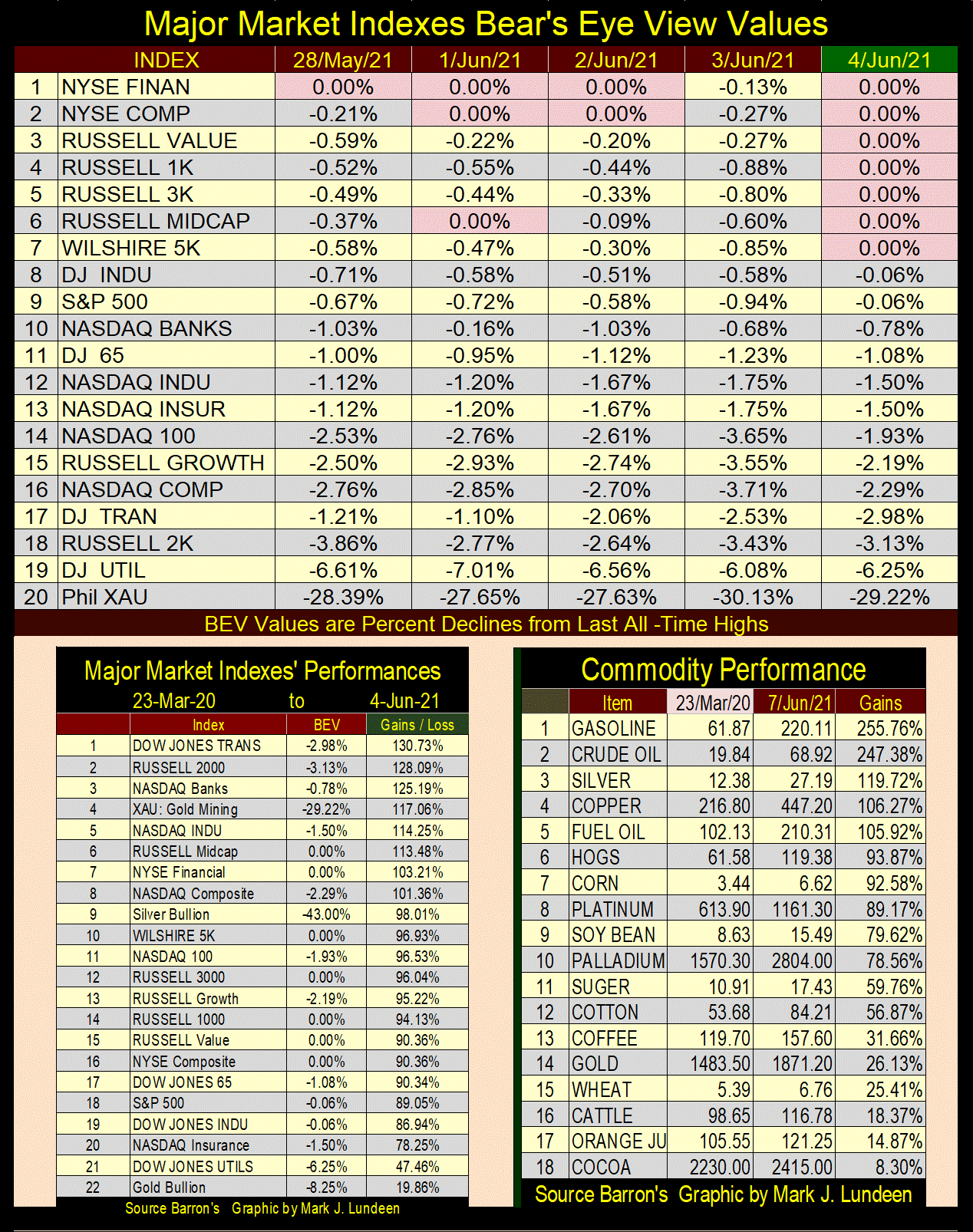
But there is a problem with this, and a big one at that when we compare the two tables above. It’s not natural seeing the major indexes on the left advance by triple and big double-digit percentages after only fourteen months, but there it is.
And what this is, is a consequence of the FOMC “injecting” humongous gobs of dollars into the financial system. What the table on the right proves is that for the first time since the early 1980s, “injected liquidity” is leaking into consumer prices, which will result in rising CPI inflation.
CPI inflation rising to annual double-digit percentages will pop this bubble no matter what the FOMC does. Double-digit CPI inflation will ultimately result in double-digit bond yields and interest rates whether the FOMC likes it or not. When this becomes widely recognized, this fact will devastate market valuations in the financial markets, and real estate. Maybe not just yet, but in its own good time this will become apparent to all.
The NYSE 52Wk H-L Nets this week saw three days where it closed above my 300 threshold. As seen in the “Day’s BEV Zero” column, it’s been 19 days since the Dow Jones’ last BEV Zero. It won’t be another 19 before the Dow Jones sees its next.
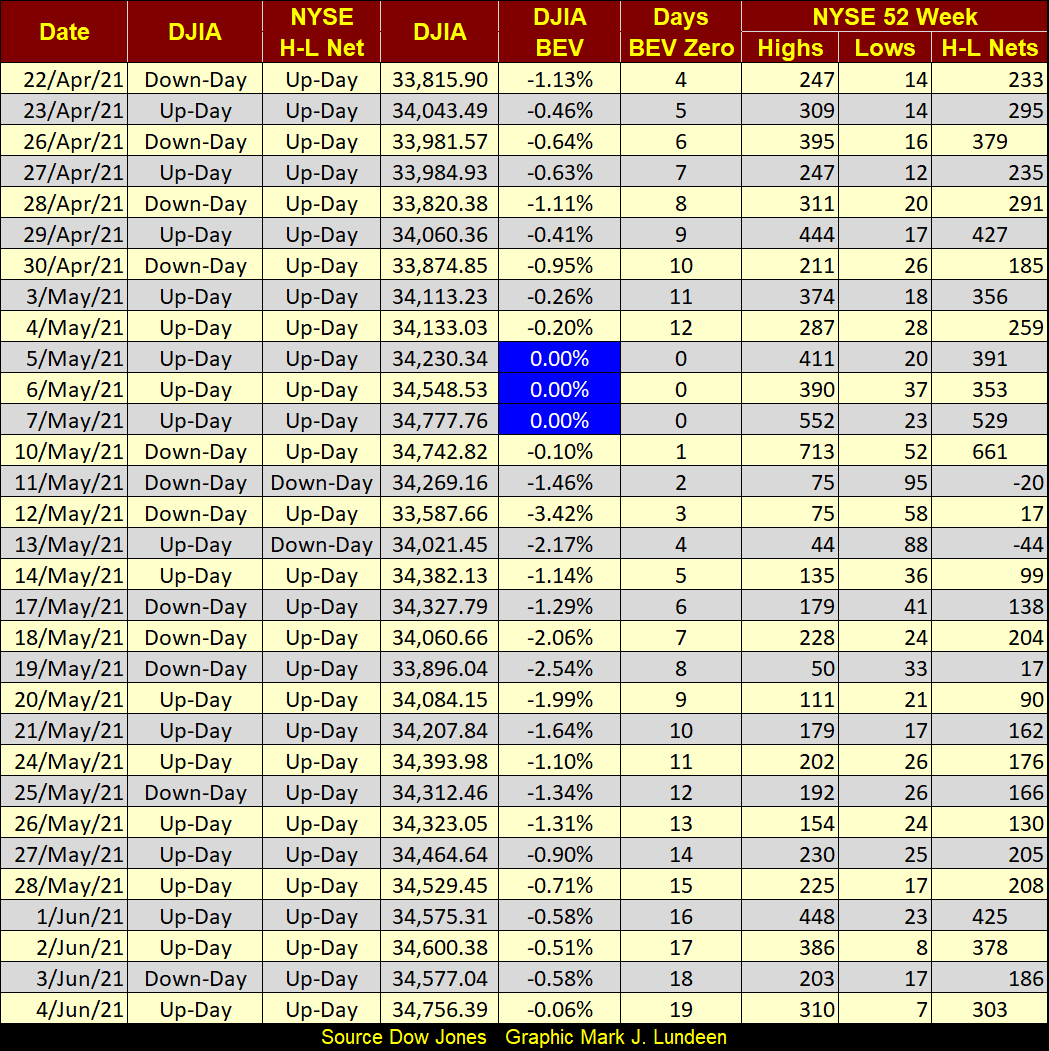
In the daily bar chart below, the Dow Jones for the past month has taken a little break; let’s call it a mini-correction. Now at the start of June, it is refreshed and ready to go on to higher levels.
Why do I believe this? Because I don’t see any days of extreme market volatility in the daily bars below, days the Dow Jones has moved +/- 2% or more from a previous day’s closing price. As the current advance is now firmly established, until we see some oversized daily percentage moves in the Dow Jones below, its best assuming this advance will continue until it terminates itself with a series of Dow Jones 2% days.
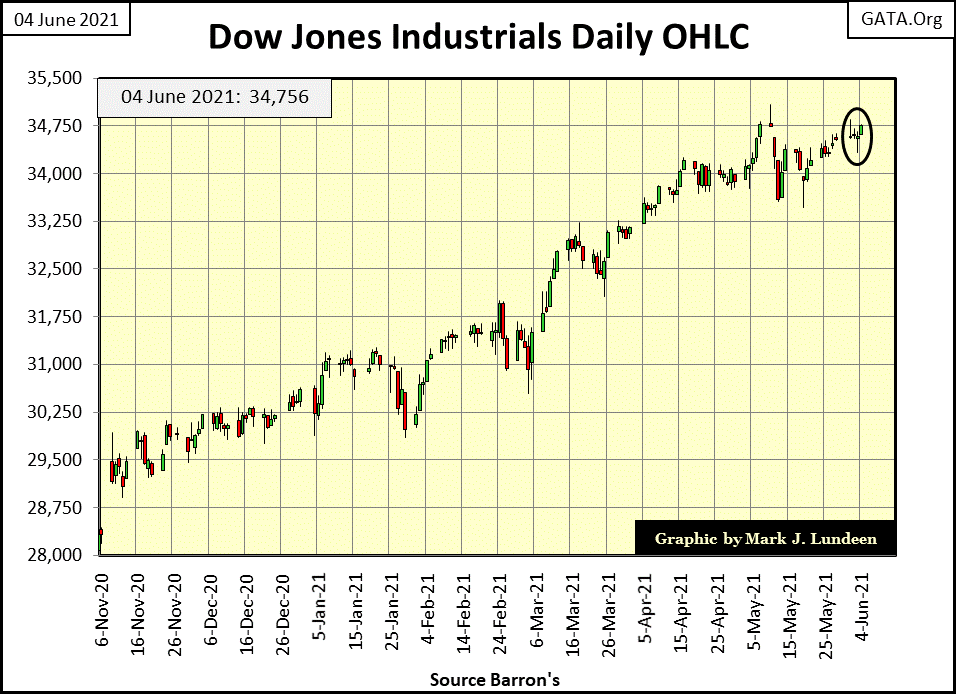
I’m not saying anything new or radical here, as since the 1920s all major market advances have been terminated with the arrival of days of extreme volatility (aka Dow Jones 2% days). The market hasn’t seen one since January 29th. And until we see two or three of them in a week or so, I’m staying bullish on the market as I sit high up in the market’s peanut gallery cheering the bulls on.
Here’s a chart plotting every day of extreme market volatility since January 1900. When the Dow Jones begins seeing daily moves of over 2%, be they up or down days, investors should place some distance between their wealth and the stock market.
One would expect seeing the biggest daily advances happening during bull markets. But the last 121 years of market history proves that is not true; that in fact its during the big-bear markets that the Dow Jones sees its big double-digit percentage advances. These oversized daily advances are just Mr Bear’s way of drawing the sheep back into his meat grinder. What a stinker that guy is!
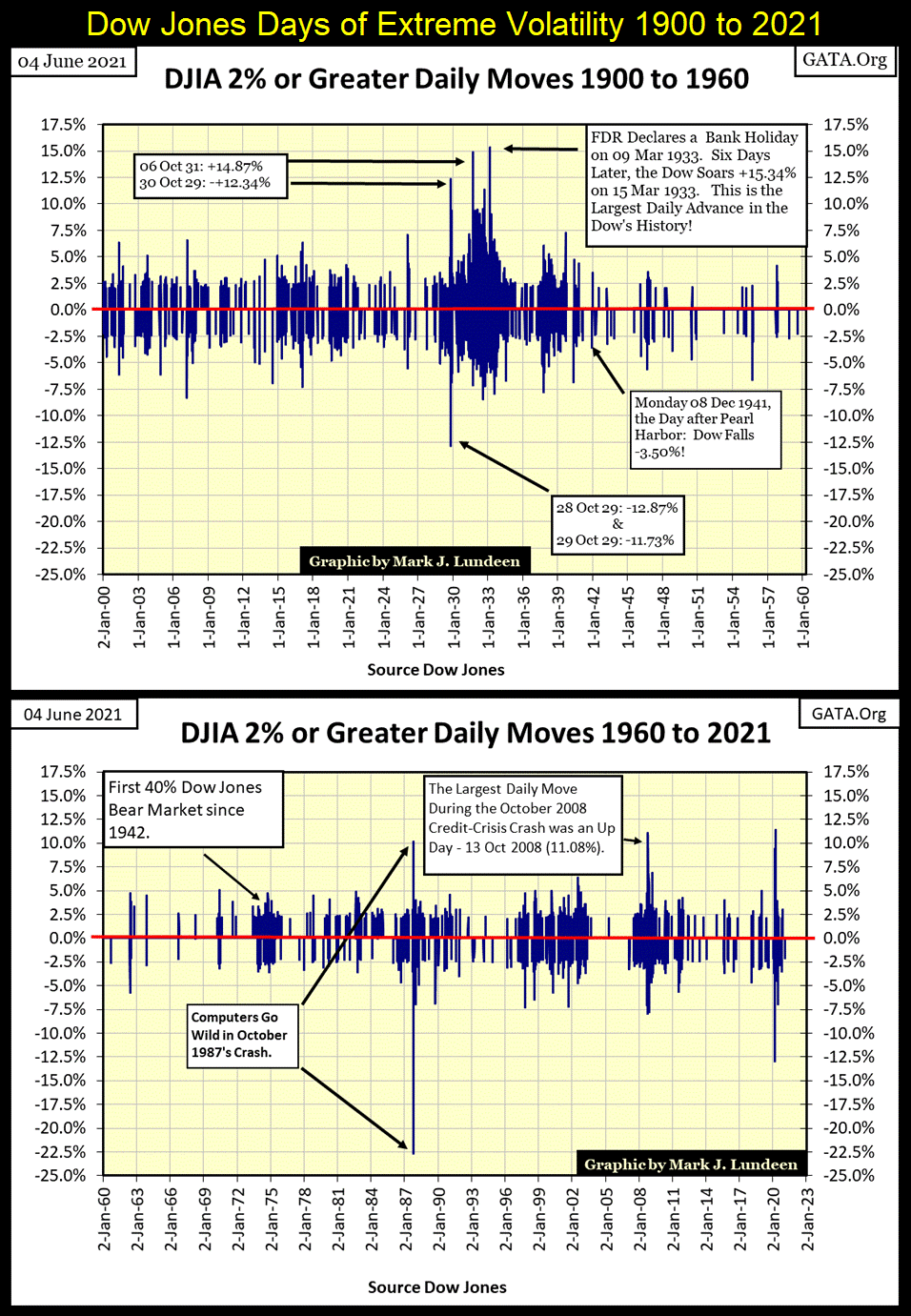
People have stopped thinking about the out-of-nowhere market crash of March 2020, but something big, bad and ugly was rising up in the markets early last year.
Look at the extremes in daily volatility for the Dow Jones from fourteen months ago. Forgetting the volatility for 1987 above, which was from a computer program going stupid, a problem quickly corrected. The volatility for those 27 NYSE trading sessions were more extreme than anything seen in the sub-prime mortgage crash, or anything else since 1960.
If you promise not to tell anyone, I’ll tell you a little secret; gold and silver mining companies are in the early stages of a historic & massive bull market – shoo!
Why do I think that? They just are and few people are aware of it. Which is to be expected as most investors (professional and retail) always follow the crowd. Not that being a crowd follower is always bad. Actually, it can be a damn fine strategy as the crowd always follows those investments that are in bull markets. So, following established market advances is how one makes money in the markets, until investors decide to stay at the party after Mr Bear crashes the festivities.
But to make the BIG MONEY, one has to identify a big market advance in its early stages, before the crowd comes in, which is exactly the situation gold and silver mining is in now. I’ll show you my reasoning why I’m so bullish on the precious metal miners, and then you can come to your own conclusions, because after all it is your money.
Let’s look at the Barron’s Gold Mining Index going back to January 1920, chart below. First thing to note is before 1970 there wasn’t much to see. Second that after 1970 the BGMI has been oscillating between 1600 on the high side and 200 on the dips. For someone seeking an investment where one could hold on for the long term, gold and silver mining for the past fifty years hasn’t been it.
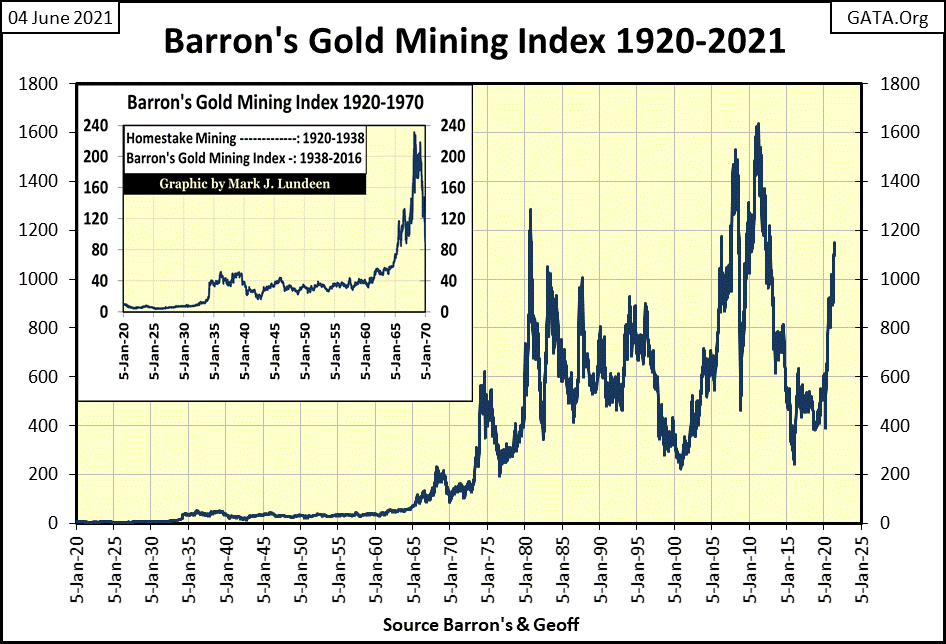
There’s a better way to look at the BGMI data above. Below (actually one table and one chart below) is a Bear’s Eye View (BEV) chart for the past 100 years for the Barron’s Gold Mining Index. Take a moment to compare these two charts, the BGMI as published (above), and the BGMI in the BEV format below.
Barron’s began publishing this data in early 1938. But a good friend of mine (Goeff) went to the trouble of getting weekly data on Homestake Mining (one of the two original gold miners in the index) so I could push this data series back to January 1920.
Thank you Goeff!
I love the BEV format, as looking at a historical market series after a century of monetary inflation is best visualized as Mr Bear sees markets. Each new all-time high (aka BEV Zeros) is seen as a Big Fat Zero (0.00%), and no more! Any data point not a new all-time high is registered as a negative percent claw back by Mr Bear, as that is all he’s interested in; how large a percentage he can claw back from the bulls!
So, a BEV plot compresses market price data into a range of 100%; with 0.00% a new all-time high, and -100% a total wipeout in valuation.
Looking at the plot below (actually one table and one chart below), before August 1971 (vertical red dashed line), the BGMI suffered from two large claw backs from Mr Bear. One in the 1920s as the Dow Jones was in a massive bull market, and again in the early 1940s when WWII deflated most financial assets, including the Dow Jones.
And like the Dow Jones, the BGMI followed their common April 1942 bottom with a big-bull market that peaked in the 1960s. The Dow Jones’ peaked in February 1966 advancing by 989%. The BGMI peaked two years later in March 1968, advancing by 1292%. So, there have been times when investing in gold and silver mining have been a successful investment strategy. I’m expecting that will once again be true sometime in the foreseeable future.
Following August 1971, volatility in the BGMI changed significantly. There were to be new all-time highs, but not many, which were followed by percentage claw backs of 65% and more.
Below is a frequency table for the BGMI before and after August 1971. This table records how many weekly closings the BGMI closed at a new all-time high (BEV Zero / 0.00%), or percentage claw backs from these BEV Zeros in increments of 5%. Take a look at the BGMI’s BEV chart, as you look over this this table.
The 0% row is the number of new weekly all-time highs. The -0.0001% row are the weekly closings just short of a new all-time high, but not more than 5% from one. I call these weekly closings in “scoring position.”
The difference between before and after August 1971 is remarkable. Also note how before August 1971 the BGMI maximum bear market low was between -65% and -70%, with ten weekly closings in this row. After August 1971, the BGMI saw 363 weekly closings (seven years) in the -70% and below rows.
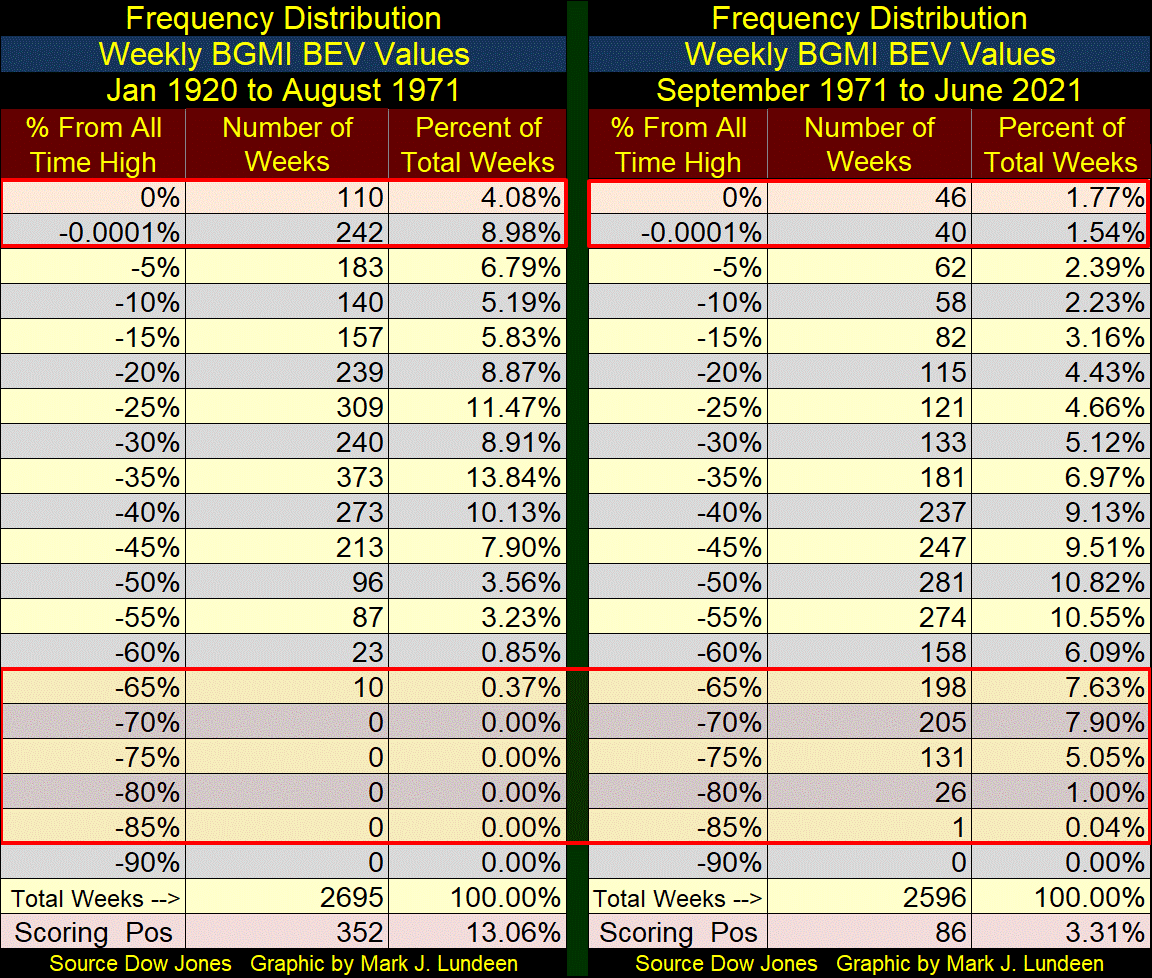
After August 1971, something changed for the worse for the BGMI. It’s been fifty years of this bearish market action, and for that reason few people take the gold and silver miners seriously. But it’s also been fifty years of monetary malfeasance by the FOMC, and that changes everything for the old monetary metals and their miners in the coming collapse of the dollar based global financial markets.
Think not? Below is a chart of the monthly changes in the FOMC’s holdings of US Treasury debt in billions-of-dollars. The idiot savants dictating “monetary policy” have yet to recover from the sub-prime mortgage fiasco (2002-08), their obscene “Not QE#4” proves that.

No “reserve currency” deserving the name can withstand the abuse the dollar has seen above, and remain a reserve currency. And all this abusive “monetary policy” has been for the benefit of America’s politicians, bankers and academics. I’m assuming the dollar’s current status as a “reserve currency” will be short lived from here; still, it could go on for a few years for lack of a suitable replacement.
I say this with no joy. The people responsible for this in Washington, Wall Street and Ivy League Universities should be buggy whipped on live TV for what they have done. But that isn’t going to happen, not when they can blame it all on President Trump and spend countless hours of investigations on the Trump Organization’s “responsibility for the dollar’s collapse.”
Until then, I’m just going to back up the truck and load up all the precious metals assets I can afford, and the gold and silver miners should benefit significantly from what is to come.
Now finally, on to the BEV chart for the BGMI. Take a good look at the chart for a moment. What happened in August 1971?
The US Treasury “temporarily” (yeah, they lied to us) took the dollar off the Bretton Woods’ $35 gold peg, replacing gold with the petrol-dollar. The dollar was now referred to as the petrol-dollar, as all crude oil sold in the international market could be sold only in US dollars.
That was Henry Kissinger’s idea, to keep the dollar relevant in the global market place by convincing key OPEC members to use US dollars exclusively in the global crude oil market in exchange for protection by the US Military. Iraq’s Saddam Hussein and Libya’s Muammar Gaddafi wanted to sell their crude oil in other currencies, and we all know how that ended for them.
For the past fifty years the petrol-dollar worked pretty well. However, as you see below the BGMI didn’t take it very well, nor did gold and silver bullion, metals that once served the world as money...
* * *
Read Full Story »»»
 DiscoverGold
DiscoverGold
Information posted to this board is not meant to suggest any specific action, but to point out the technical signs that can help our readers make their own specific decisions. Caveat emptor!
• DiscoverGold
Recent GLD News
- Form 10-Q - Quarterly report [Sections 13 or 15(d)] • Edgar (US Regulatory) • 02/08/2024 03:33:22 PM
- Form FWP - Filing under Securities Act Rules 163/433 of free writing prospectuses • Edgar (US Regulatory) • 01/19/2024 05:18:16 PM
- Crypto: RNDR, LINK, CHZ Emerge as Wednesday’s Top Performers, Ethereum Pilots Dencun Update, and More • IH Market News • 01/17/2024 04:51:44 PM
- Form 424I - • Edgar (US Regulatory) • 12/27/2023 04:04:08 PM
- Form FWP - Filing under Securities Act Rules 163/433 of free writing prospectuses • Edgar (US Regulatory) • 12/22/2023 09:02:08 PM
- Form 10-K - Annual report [Section 13 and 15(d), not S-K Item 405] • Edgar (US Regulatory) • 11/22/2023 07:49:08 PM
- Form FWP - Filing under Securities Act Rules 163/433 of free writing prospectuses • Edgar (US Regulatory) • 09/14/2023 02:12:55 PM
- Form 8-K - Current report • Edgar (US Regulatory) • 09/12/2023 08:02:07 PM
- Gold Stabilizes Near One-Month Highs as U.S. Interest Rate Hike Expectations • IH Market News • 08/31/2023 12:43:38 PM
- Gold Closes Higher, With Strong Retreat In Treasury Interest Rates And Dollar Low • IH Market News • 08/29/2023 06:20:49 PM
- Form 10-Q - Quarterly report [Sections 13 or 15(d)] • Edgar (US Regulatory) • 08/07/2023 06:55:27 PM
Axis Technologies Group and Carbonis Forge Ahead with New Digital Carbon Credit Technology • AXTG • Apr 24, 2024 3:00 AM
North Bay Resources Announces Successful Equipment Test at Bishop Gold Mill, Inyo County, California • NBRI • Apr 23, 2024 9:41 AM
Epazz, Inc.: CryObo, Inc. solar Bitcoin operations will issue tokens • EPAZ • Apr 23, 2024 9:20 AM
Avant Technologies Launches Advanced AI Supercomputing Network and Expansive Data Solutions • AVAI • Apr 23, 2024 8:00 AM
BestGrowthStocks.com Issues Comprehensive Analysis of Triller Merger with AGBA Group Holding Limited • AGBA • Apr 22, 2024 1:00 PM
Cannabix Technologies to Present Marijuana Breathalyzer Technology at International Association for Chemical Testing (IACT) Conference in California • BLO • Apr 22, 2024 8:49 AM









